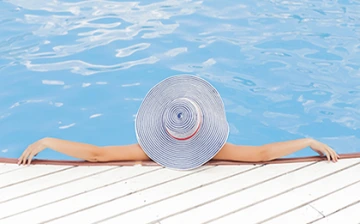Pool Chemicals: The Overlooked Side of Swimming Safety
Nothing says summer like jumping into a swimming pool filled with cool, sparkling water.

Nationally, there are more than 10 million swimming pools, which are used for recreation, exercise and cooling off during hot summer weather. Arizona and many other states have educational programs to teach children how to swim and laws or guidelinesto help families and communities prevent drowning.
With drowning among the top causes of death in children who die of unintentional injuries, these water-safety programs are crucial. But frequently they leave out another important aspect of pool safety: using caution with chemicals.
The benefits of swimming pool chemicals are numerous. They kill germs that can make swimmers sick. They balance the pH level, ensuring that the water is not too acidic or too alkaline. And they improve water quality by preventing algae growth and corrosion or clogging of pool equipment.

Chemicals like chlorine and acid used to keep swimming pools clean and inviting can be very dangerous if not used carefully.
When common pool chemicals like chlorine and muriatic acid come into direct contact with living tissue, they can cause a range of reactions from irritating to severely damaging. If you inhale the dust or odor from these chemicals, you may experience coughing, choking, chest discomfort and shortness of breath. If the material gets into your eyes, it can cause redness, tearing and, potentially, eye damage. If the chemical spills on your skin, it can cause redness, pain or even a chemical burn.
This summer, follow these safety tips to make sure you splash in the pool—not in the chemicals:
- Always follow directions on the product label, and wear safety gear such as gloves and eye protection as directed.
- Use pool chemicals in an open, well-ventilated area. Ensure any wind will carry fumes or dust away from people.
- Keep children out of the area when handling chemicals.
- Clearly label and store chemicals securely away from children and pets.
- Never mix pool chemicals together.
- Add each individual chemical to the water as directed. Never reverse the process by adding water to a chemical.
- Avoid any direct contact with eyes or skin. If you spill or splash a chemical on yourself, immediately rinse your eye or skin with lukewarm water. Continue gently rinsing for at least 15 minutes. Call the poison center if redness, pain or burning persists.
- If you experience shortness of breath, coughing or burning after inhaling the fumes from pool chemicals, get some fresh air or take a warm shower and breathe in the mist from the clean water. If symptoms continue, call 911 and get medical attention.

Nothing says summer like a relaxing dip in the swimming pool.
If you have questions or concerns about exposure to pool chemicals or any other dangerous substances, call the toll-free national hotline to reach your local poison center: 1-800-222-1222. If you live anywhere in Arizona except Maricopa County, this number will connect you to our experts at the Arizona Poison and Drug Information Center in Tucson. It’s free, confidential and available 24 hours a day, seven days a week.
About the Author
Keith Boesen, PharmD, CSPI, served as the director of the Arizona Poison and Drug Information Center and an instructor at the University of Arizona College of Pharmacy. He began as an intern at the poison center in 2000 while he was pursing his doctor of pharmacy degree. He became a full-time employee in 2002 and was named director of the center in 2009. Dr. Boesen completed advanced training to become a certified specialist in poison information and is currently training for the additional designation of diplomate of the American Board of Applied Toxicology. In 2018, Dr. Boesen accepted a position with Rare Disease Therapeutics, Inc.
Dr. Boesen has written chapters for toxicology references and assisted with articles published in various medical journals. He was involved with the clinical trials for new rattlesnake and scorpion antivenoms, as well as with various research projects with pharmacy students ranging from rattlesnake venom variability to symptoms associated with new designer drugs.

